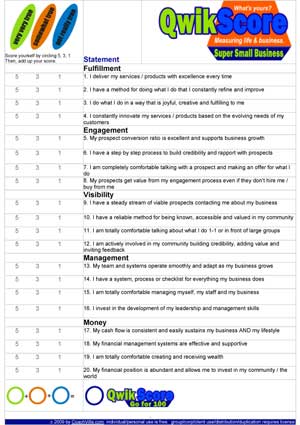 Let’s face it. The time to ask yourself, “Is my business running smoothly?” is NOT after you have just had a flat tire and are bumping down the road. The time to ask that question and analyze its answer is during the business planning process AND throughout the year.
Let’s face it. The time to ask yourself, “Is my business running smoothly?” is NOT after you have just had a flat tire and are bumping down the road. The time to ask that question and analyze its answer is during the business planning process AND throughout the year.A business is a complex machine with many moving parts. Well-maintained, it works smoothly and takes you where you want to go. But if just one part is neglected over time or overlooked, an eventual breakdown is certain.
To begin the process, take a look at your systems and how they connect to the big picture. Where, exactly, do they exist in the framework of your business and how efficiently are they running? Jennifer James, in THINKING IN THE FUTURE TENSE, reminds us that “systems thinking” can bridge the gap between reality and perception, and is probably the best way to problem solve (189.) Systems thinking “helps us understand that all parts of a business or a process are connected, and that when one part is challenged, all the others are as well” (189.) Typically, we may look at problems in isolation, but that may not solve the underlying systemic issues.
Let’s take an example of lagging sales. Agents are not making production goals; therefore, the cash flow or profit bottom line is not being met for the business. You could dismiss the problem as “it’s the market,” and continue to slump in sales. You could blame your team and look for new help. But if you look at all the systems that feed productivity: lead generation and marketing, listing systems, follow-up, people and support systems, you may be able to discover various cogs in the wheel that are preventing progress. Does listing inventory need to increase in order to produce leads? Are follow-up systems being utilized? Do team members need more mentoring or training? Could the answer to lagging sales be a team retreat that re-motivates and energizes the team members?
Systems thinking allows for and demands creative problem solving. Take Steve Jobs of Apple computers. Infamously “fired” at one time from his own company, Jobs loved the business too much to stay away from it. After creating PIXAR (among other projects) while on hiatus from Apple, he returned to regenerate not only the product (Macs) but the industry itself. While launching and perfecting iMovie (a consumer-friendly video-editing application) for the Mac, he realized that software wasn’t enough. In order to function properly, he concluded, it had to work in conjunction with several other components. He became committed to the goal that Mac would offer something unique by developing whole business systems for the personal computer. And of course from there, he made history: launching a little digital music business with iPod. (See pages 257-258 INSIDE STEVE’S BRAIN by Lenader Kahney.) Systems thinking was the key.
Systems thinking is not so much thinking “outside the box” as it is the wide-angle view. So pan the vista of your own business. What systems are in place? Are any missing? Of those that are operating, are they running as efficiently as they could be? Put the individual pieces together to create a smooth and successful whole. Problem solve with imagination and collaboration to fix issues that slow you down. Be cognizant throughout the year. Create and maintain a smooth-running machine.
